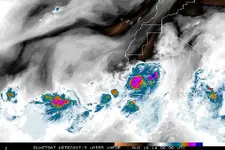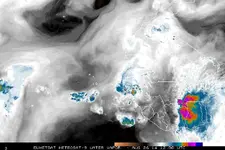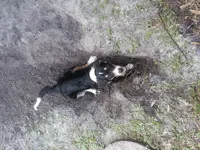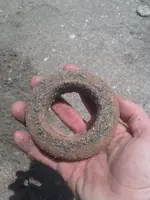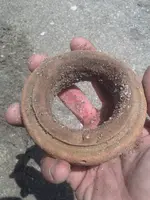You are using an out of date browser. It may not display this or other websites correctly.
You should upgrade or use an alternative browser.
You should upgrade or use an alternative browser.
storms rolling off of Africa (tropics heating up)
- Thread starter GatorBoy
- Start date
sponge
Bronze Member
Its modern but ill take it. First good storm find.
sponge using smoke signals.
sponge using smoke signals.
hubcap76
Hero Member
- Joined
- Jun 27, 2013
- Messages
- 532
- Reaction score
- 241
- Golden Thread
- 0
- Location
- Treasure Coast, Florida
- 🏆 Honorable Mentions:
- 1
- Detector(s) used
- Minelab Sovereign Xs 2a pro, Excalibur ll, Explorer II
- Primary Interest:
- All Treasure Hunting
Nice find, and still wearable. Almost free from kid duty for a few hours about to do some condo walking myself.
powered by pull tabs
powered by pull tabs
lost items recovery
Bronze Member
Its modern but ill take it. First good storm find. sponge using smoke signals.
Ooh! Looks like a pricy one! Hoping for you! Thumbs up!!!
Sent from my iPhone using TreasureNet
MiamiFox
Hero Member
- Joined
- Aug 2, 2013
- Messages
- 765
- Reaction score
- 477
- Golden Thread
- 0
- Location
- Miami Florida
- Detector(s) used
- CTX 3030. Excal II, Garrett AT Pro, Howie Scoop
Colt Python .357 6"
Winchester 94 30-30
- Primary Interest:
- Beach & Shallow Water Hunting
I wasn't into metal detecting when Hurricane Andrew hit Miami.
We though Andrew was going to hit north of Miami where we lived so we went to stay with family in south Miami and that's were he came.
It was bad, at 5AM we had 4 adults, 3 dogs, and 2 cats in a bathroom with one flash light and no AC for two hours while the roof was being ripped off.
I remember the dogs and cats in the bath tub in total harmony, as if they had some kind of truce going on or maybe thinking it was the end of the world like we did.
It was over by Sunrise and I remember going outside to total silence.
If I had a metal detector back then it would have been the the last thing on my mind.
We though Andrew was going to hit north of Miami where we lived so we went to stay with family in south Miami and that's were he came.
It was bad, at 5AM we had 4 adults, 3 dogs, and 2 cats in a bathroom with one flash light and no AC for two hours while the roof was being ripped off.
I remember the dogs and cats in the bath tub in total harmony, as if they had some kind of truce going on or maybe thinking it was the end of the world like we did.
It was over by Sunrise and I remember going outside to total silence.
If I had a metal detector back then it would have been the the last thing on my mind.
lost items recovery
Bronze Member
Be careful folks. Spoke to a buddy from just south of the treasure coast area today. He filled me in on his gold and diamond ring find, sea turtles, and their eggs washing ashore and surfacing from the sand and rescued as many as he could. The problem is he was almost sucked out on numerous occasions and he's a big guy at 6'4"ish. Be safe everyone! Sent from my iPhone using TreasureNet
Last edited:
el padron
Hero Member
- Joined
- Oct 29, 2010
- Messages
- 920
- Reaction score
- 503
- Golden Thread
- 0
- Location
- Southern California
- Detector(s) used
- The content of this space is contingent upon principals acceptance, execution and or final disposition / funding of an approved product endorsement agreement
- Primary Interest:
- Other
Wrong, Lookindown is correct, 3 cat 5 hurricanes have hit US in 20th century.
1935 "labor Day" Florida Keys Hurricane
Hurricane Camille, Mississippi in August 18, 1969
Hurricane Andrew, Dade County, Fla. Aug. 24, 1992
History of Category 5 hurricanes
By Jack Williams, USATODAY.com
Category 5 hurricanes, with winds faster than 155 mph, are rare with only three hitting the USA in the 20th century and only 23 known to have reached this strength at any time during their lives between 1928 and 2003.
(Graphic: The hurricane intensity scale)
The three Category 5 storms to hit the USA were the 1935 Florida Keys "Labor Day" hurricane, Hurricane Camille, which hit Mississippi in 1969, and Hurricane Andrew, which hit Dade County, Fla., on Aug. 24, 1992.
The records aren't good enough to say whether any earlier storms that hit the USA would be Category 5 by today's standards.
Hurricane Isabel in 2003 was the Atlantic's first Category 5 hurricane of the 21st Century, but it weakened to a category 2 storm before hitting the USA. Fortunately, many Category 5 storms weaken before hitting land. Of the 23 known Category 5 storms since 1928, only eight were still Category five when they hit land. (Related: NCDC list of Category 5 storms)
Before Isabel, Mitch had been the latest Category 5 storm in the Western Hemisphere. Before Mitch, it was Linda, in the Eastern Pacific in September 1997.
El Niño warming of the Pacific off the Mexican Coast helped give Hurricane Linda the energy needed to make it the strongest storm ever observed in the eastern Pacific. On Sept. 11 and 12, Hurricane Linda's winds were blowing at an estimated 185 to 190 mph, making it the strongest hurricane ever observed in the eastern Pacific. For a time Linda threatened to hit the California Coast. The cool water along the California Coast would almost surely had wakened it to a tropical storm. But Linda turned away to die over the open Pacific.
Hurricane Hugo in 1989 was also briefly a Category 5 storm when it was over the Atlantic east of the Bahamas after hitting Puerto Rico and before hitting South Carolina. On Sept. 15 at 2 p.m. ET and again at 8 p.m. ET, hurricane hunter airplanes estimated Hugo's surface winds at just over 155 mph and 161 mph. It hit South Carolina north of Charleston on Sept. 22 as a Category 4 storm.
The strongest hurricane ever measured in the Western Hemisphere was Gilbert in 1988. The 888 millibar central pressure recorded in Gilbert on Sept. 14, 1988, is the lowest ever recorded in an Atlantic Ocean, Caribbean Sea or Gulf of Mexico storm.
The world record for the lowest tropical cyclone pressure is 870 millibars in Typhoon Tip in the northwest Pacific Ocean on Oct. 12, 1979.
Gilbert was at 19.7 degrees north latitude, 83.8 west longitude in the western Caribbean Sea, south of the Cayman Islands, when a National Oceanic and Atmospheric Administration WP-3D aircraft recorded the record low pressure.
Gilbert weakened some, but still hit Mexico's Yucatan Peninsula as a Category 5 storm causing extensive damage. Gilbert also caused serious damage in Jamaica, the Cayman Islands, and farther west in Mexico when it came ashore on the Gulf Coast south of Brownsville, Texas, after crossing the Yucatan and regaining some of the strength it lost crossing the Yucatan Peninsula.
USATODAY.com[/QUOTE
Congratulations on all you have once again brushed up on off of Wikipedia, But there is very little evidence a category 5 hurricane has struck a coastline, certainly in recent memory,
It is arguable that it has, and the horror that would occur should one ever strike a modern populated coastal community could never be garnered from surfing the internet from a couch.
It is you who are wrong.
Last edited:
GatorBoy
Gold Member
- Joined
- May 28, 2012
- Messages
- 14,716
- Reaction score
- 6,156
- Golden Thread
- 0
- Primary Interest:
- All Treasure Hunting
- #109
Thread Owner
Please don't turn this into an argument kind of a thread I don't know why you're arguing fact here but there's already been wind measurements documented to prove treasure hunter was correct and so was the documentation he quoted.
I know your forum name means the boss... And all...but... Please
I know your forum name means the boss... And all...but... Please
el padron
Hero Member
- Joined
- Oct 29, 2010
- Messages
- 920
- Reaction score
- 503
- Golden Thread
- 0
- Location
- Southern California
- Detector(s) used
- The content of this space is contingent upon principals acceptance, execution and or final disposition / funding of an approved product endorsement agreement
- Primary Interest:
- Other
Please don't turn this into an argument kind of a thread I don't know why you're arguing fact here but there's already been wind measurements documented to prove treasure hunter was correct and so was the documentation he quoted.
I know your forum name means the boss... And all...but... Please
Ok, so can we get back to hoping for a big coastal storm so we can go metal detecting again?
GatorBoy
Gold Member
- Joined
- May 28, 2012
- Messages
- 14,716
- Reaction score
- 6,156
- Golden Thread
- 0
- Primary Interest:
- All Treasure Hunting
- #111
Thread Owner
Ok, so can we get back to hoping for a big coastal storm so we can go metal detecting again?
I'm a grown man... Most of us are big boys I've been through several large coastal storms... I don't appreciate your condescendance but to put it bluntly to answer your question yes .. In a perfect scenario it'll cruise right up the coast taking away million tons of replenishment sand crap that was dumped on the shoreline in my area
Last edited:
hubcap76
Hero Member
- Joined
- Jun 27, 2013
- Messages
- 532
- Reaction score
- 241
- Golden Thread
- 0
- Location
- Treasure Coast, Florida
- 🏆 Honorable Mentions:
- 1
- Detector(s) used
- Minelab Sovereign Xs 2a pro, Excalibur ll, Explorer II
- Primary Interest:
- All Treasure Hunting
Tent stakes > politics
powered by pull tabs
powered by pull tabs
Wrong, Lookindown is correct, 3 cat 5 hurricanes have hit US in 20th century.
1935 "labor Day" Florida Keys Hurricane
Hurricane Camille, Mississippi in August 18, 1969
Hurricane Andrew, Dade County, Fla. Aug. 24, 1992
History of Category 5 hurricanes
By Jack Williams, USATODAY.com
Category 5 hurricanes, with winds faster than 155 mph, are rare with only three hitting the USA in the 20th century and only 23 known to have reached this strength at any time during their lives between 1928 and 2003.
(Graphic: The hurricane intensity scale)
The three Category 5 storms to hit the USA were the 1935 Florida Keys "Labor Day" hurricane, Hurricane Camille, which hit Mississippi in 1969, and Hurricane Andrew, which hit Dade County, Fla., on Aug. 24, 1992.
The records aren't good enough to say whether any earlier storms that hit the USA would be Category 5 by today's standards.
Hurricane Isabel in 2003 was the Atlantic's first Category 5 hurricane of the 21st Century, but it weakened to a category 2 storm before hitting the USA. Fortunately, many Category 5 storms weaken before hitting land. Of the 23 known Category 5 storms since 1928, only eight were still Category five when they hit land. (Related: NCDC list of Category 5 storms)
Before Isabel, Mitch had been the latest Category 5 storm in the Western Hemisphere. Before Mitch, it was Linda, in the Eastern Pacific in September 1997.
El Niño warming of the Pacific off the Mexican Coast helped give Hurricane Linda the energy needed to make it the strongest storm ever observed in the eastern Pacific. On Sept. 11 and 12, Hurricane Linda's winds were blowing at an estimated 185 to 190 mph, making it the strongest hurricane ever observed in the eastern Pacific. For a time Linda threatened to hit the California Coast. The cool water along the California Coast would almost surely had wakened it to a tropical storm. But Linda turned away to die over the open Pacific.
Hurricane Hugo in 1989 was also briefly a Category 5 storm when it was over the Atlantic east of the Bahamas after hitting Puerto Rico and before hitting South Carolina. On Sept. 15 at 2 p.m. ET and again at 8 p.m. ET, hurricane hunter airplanes estimated Hugo's surface winds at just over 155 mph and 161 mph. It hit South Carolina north of Charleston on Sept. 22 as a Category 4 storm.
The strongest hurricane ever measured in the Western Hemisphere was Gilbert in 1988. The 888 millibar central pressure recorded in Gilbert on Sept. 14, 1988, is the lowest ever recorded in an Atlantic Ocean, Caribbean Sea or Gulf of Mexico storm.
The world record for the lowest tropical cyclone pressure is 870 millibars in Typhoon Tip in the northwest Pacific Ocean on Oct. 12, 1979.
Gilbert was at 19.7 degrees north latitude, 83.8 west longitude in the western Caribbean Sea, south of the Cayman Islands, when a National Oceanic and Atmospheric Administration WP-3D aircraft recorded the record low pressure.
Gilbert weakened some, but still hit Mexico's Yucatan Peninsula as a Category 5 storm causing extensive damage. Gilbert also caused serious damage in Jamaica, the Cayman Islands, and farther west in Mexico when it came ashore on the Gulf Coast south of Brownsville, Texas, after crossing the Yucatan and regaining some of the strength it lost crossing the Yucatan Peninsula.
USATODAY.com[/QUOTE
Congratulations on all you have once again brushed up on off of Wikipedia, But there is very little evidence a category 5 hurricane has struck a coastline, certainly in recent memory,
It is arguable that it has, and the horror that would occur should one ever strike a modern populated coastal community could never be garnered from surfing the internet from a couch.
It is you who are wrong.
Go back and look at my post, the first was article from USA News not Wiki.
Here is couple more and note they are NOT Wiki...
"According to a reanalysis released by the National Hurricane Center in April 2014, Hurricane Camille made landfall on the night of Aug. 17-18 with winds estimated at 175 mph and a central pressure of 900 millibars (26.58 inches) – the second-strongest landfalling hurricane by pressure in U.S. history.
The Mississippi Gulf Coast was devastated by a storm surge of up to 24.6 feet, contributing to a death toll of 143 along the Gulf Coast. Another 113 died in Virginia due to flash flooding and mudslides."
http://www.weather.com/news/weather...intense-atlantic-hurricanes-20130911?pageno=5
"Hurricane Andrew caused an estimated $26 billion damage in the United States making it the most expensive natural disaster in United States history. At landfall in southern Dade County, Florida, the central pressure was 922 millibars, which is the third lowest this century (after the 1935 Florida Keys Labor Day storm and Hurricane Camille in 1969) for a landfalling hurricane in the U.S.
As with many of the worst Atlantic hurricanes, Andrew was born as a result of a tropical wave which moved off the west coast of Africa wave and passed south of the Cape Verde Islands. It became a tropical storm on August 17, 1992 and moved uneventfully west northwestward across the Atlantic. Significant changes occurred in the large-scale environment of Andrew on August 21 as a deep high pressure center developed over the southeast U.S. and extended eastward to north of the tropical storm. In response to the much more favorable environment, Tropical Storm Andrew strengthened rapidly and turned westward.
Andrew became a hurricane on August 22 and strengthened to a strong category 4 hurricane the next day. As it moved westward, it weakened to 941 millibars as it passed over Great Bahama Bank, but rapidly re-intensified as it moved over the Gulfstream on its approach to Florida. In fact, the deepening trend continued up to and slightly inland of the coast. (Eye temperatures as measured by reconnaissance aircraft suggest that convection in the eyewall and associated vertical circulation became more vigorous as the storm moved ashore). Andrew stuck Dade county on August 24th as a Category 5 hurricane, with the center first reaching the coast at the northern tip of Elliott Key. The storm devastated Dade County where it caused an estimated $25 billion in damage, especially over the Homestead area. After striking Florida, Andrew moved northwest across the Gulf of Mexico to make a second landfall in a sparsely populated area of south-central Louisiana as a Category 3 storm on August 26. In total, Andrew directly caused 26 deaths in the U.S. and indirectly caused 39 more. The number of homes destroyed was approximately 49,000, with an additional estimated 108,000 damaged."
www.srh.noaa.gov/mfl/?n=andrew
Last edited:
hubcap76
Hero Member
- Joined
- Jun 27, 2013
- Messages
- 532
- Reaction score
- 241
- Golden Thread
- 0
- Location
- Treasure Coast, Florida
- 🏆 Honorable Mentions:
- 1
- Detector(s) used
- Minelab Sovereign Xs 2a pro, Excalibur ll, Explorer II
- Primary Interest:
- All Treasure Hunting
Let's move on, insults were deleted and action was taken.......
Not trying to go to far off topic. My first impression of hurricanes was studying from a kids perspective the rebuilt pier Donna had destroyed. Left me thinking an ocean side hut should have wheels on it. In later years could not decide where such a home could be wheeled to in time. Grateful to have visited but humbled too. Bet she moved some sand and relics.
Hurricanes: Science and Society: 1960- Hurricane Donna
Hurricanes: Science and Society: 1960- Hurricane Donna
Last edited:
GatorBoy
Gold Member
- Joined
- May 28, 2012
- Messages
- 14,716
- Reaction score
- 6,156
- Golden Thread
- 0
- Primary Interest:
- All Treasure Hunting
- #120
Thread Owner
Good post thank you for adding that.. there is no real topic to this thread other than... Some folks having a conversation heading into the height of the Cape verd season
Similar threads
- Replies
- 17
- Views
- 1K
- Replies
- 0
- Views
- 1K
Users who are viewing this thread
Total: 1 (members: 0, guests: 1)

